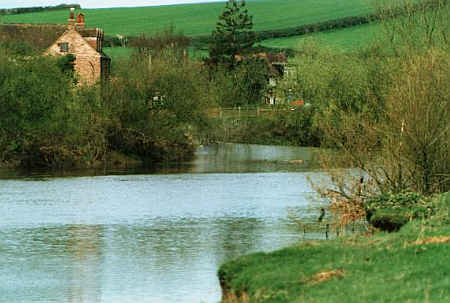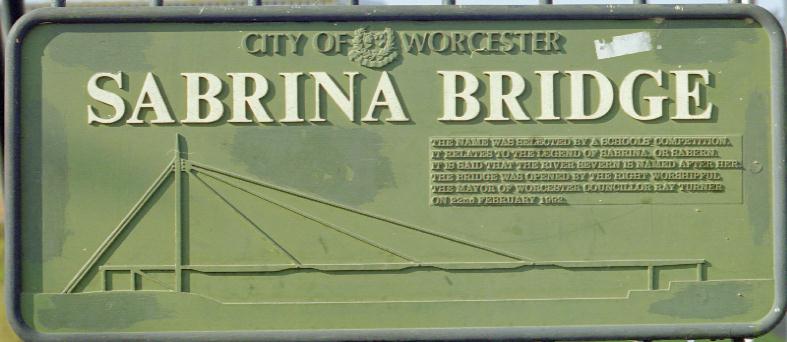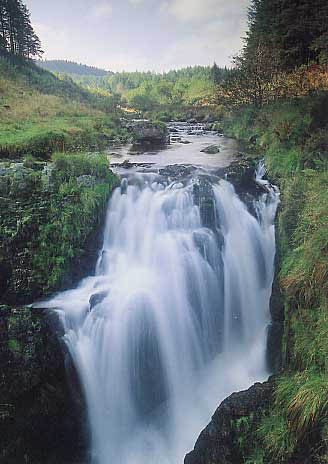-the Legend
-sabrina -severn -mythology
Sabrina: (latin) From the boundary, A Princess
Sabrina is the nymph of the Severn river. Known as Habren to the early Brits, or Hafren (Ha-vren) to the Welsh, Sabrina is the Roman title which means Princess or boundary. The Severn River begins in Wales and then goes through England close to the Welsh borders on it's way to the Bristol Channel. Sabrina is known as the goddess of river in some mythology and references to her can be found in Sir Geoffrey of Monmouth's History of the Kings of Britain and John Milton's Comus.
Sir Geoffrey of Monmouth
In History of the King's Of Britain, Sir Geoffrey of Monmouth relates the tale of how the Severn received its name. Locrine, the son of the early British King Brutus, was engaged to marry Gwendolen, the daughter of another King. Over the process of the engagement, Locrine raids a germanic tribe where a young woman named Estrildis is taken captive. Locrine is immediately attracted to Estrildis and wishes to break off his engagement to Gwendolen so that he may marry Estrildis instead. However Gwendolen's father will hear nothing of this.
Locrine marries Gwendolen who has a son. However he still loves Estrildis so he hides her and continues to see her without Gwendolen's knowledge. Estrildis gives birth to a daughter, Sabrina, or Habren.
After a period of time, Gwendolen's father dies and Locrine decides to divorce Gwendolen and marry Estrildis. Gwendolen is angry and gathers an army from her home and leads them against her husband, Locrine. In the ensuing battle, Locrine is killed and Gwendolen takes his beloved Estrildis and her daughter, Sabrina and has them thrown into the river to drown. Realizing that Sabrina was the daughter of her husband, Gwendolen decrees that the river should always be called after the princess who drowned within. The Welsh called the river Hafren, the early British, Habren and when the Romans invaded the land, they gave it the name Sabrina. The term means boundary and today the river is known as the Severn river.
Milton's Sabrina
English poet John Milton writes of Sabrina in his poem
Comus.
In this poem he's taken the original legends and expanded them somewhat.
Sabrina is portrayed as the goddess of the river. Milton shows her as a river
nymph who protects chastity and saves a virgin.
Works Cited
Monmouth, Geoffrey. The History of the Kings of Britain.
Penguin Books, New York, 1966.
Milton, John. The Poetical Works of John Milton.
Oxford, at the Clarendon Press, 1900.
World Book Encyclopedia.
World Book, Inc. Chicago, 1988.
Sabrina in other places
Sabrina fair, a play by Samuel Taylor. The 1954 movie was based on this play.
Sabrina (1954) starring Audrey Hepburn, Humphrey Bogart, William Holden. Audrey plays Sabrina, the daughter of a chauffer who falls in love with the playboy son (William Holden) of the family her father works for. Their chances of romance are foiled by the older brother Linus, played by Humphrey Bogart. For more information visit the Internet Movie Database Ltd- Sabrina 1954 or take a look at this review by James Berardinelli.
Sabrina (1995) starring
Harrison Ford, Greg Kinnear, and Julia Ormand. In this recent remake of the
old classic, Julia Ormand plays the awkward Sabrina. Julia looks in many ways
how I imagine the original Sabrina might have looked, dark hair, fair skin,
and eyes that are deep pools of water. There is a reference to Milton's Comus
in the movie and Sabrina tells Linus (Harrison Ford), "It's the story of a
water sprite who saves a virgin from a fate worse than death." Linus
questions if Sabrina is the virgin and she responds, "No, she's the savior." For
more information about this movie visit the
Internet Movie Database.
For more information on the Legend of
Sabrina visit the
Severn Tales page.
Severn River
"A thousand years hence the river will flow as it always did." ~Thomas Fuller
Where is the Severn River located?
The Severn river is located in England.
The Severn River is Britain's longest river as it winds through the West Midlands close
to the border of Wales. A great deal has happened along the banks of the Severn river.
If you would like more information about the River Severn, please visit
River Severn Tales
for current information as well as a page detailing historical events that have occured
along the river's banks.
The Severn Way has
information about paths walking the Severn, as well as a guide to canoeing the Severn
river.
The Severn Bore
 The Severn Bore is a unique tidal feature that occurs often throughout the year. Fred
Rowbotham's book The Severn Bore talks in great detail about this feature. It gives
a list of probable times when the best bore sightings will occur as well as information on
where to see the bore from land, in towns, more rural locations or actually on the river
itself. For those interested in tidal phenomenons and rivers, this book is very interesting.
The Severn Bore is a unique tidal feature that occurs often throughout the year. Fred
Rowbotham's book The Severn Bore talks in great detail about this feature. It gives
a list of probable times when the best bore sightings will occur as well as information on
where to see the bore from land, in towns, more rural locations or actually on the river
itself. For those interested in tidal phenomenons and rivers, this book is very interesting.
Portrait of the Severn
J. H. B. Peel has taken the land around the Severn in his book Portrait of the Severn and shown it through the people who grew around the river, the history behind the river, and the villages that settle along its banks. The river begins in the mountain country of Wales, and Peel describes well the journey to the river's source.
Hafren or Severn, the stream now enters a steeply pastoral valley, and then a steeper and treeless valley, and then a precipice of Forestry Commission conifers, and then for a while it becomes pastoral again, flowing sometimes as an open brook, sometimes among elms and willows, followed by a lane hundreds of feet up on the right... ...Presently the lane passes my favourite Severn Bridge-two planks and a wire handrail, slung across the foaming water-and all this while the scene grows wilder, the farms fewer, the air keener... ...Few men have followed every yard of this reach, for that would mean burrowing through copses, clambering over rocks, scaling the waterfalls. Even so, I have scaled, clambered, and burrowed awhile, for this is the reach I love best. It is secluded but not isolated; populated companionably but sparsely. Instead of passing like strangers in a scurrying street, the farmfolk and foresters linger and are pleased to meet one another. Here you are not simply a number on a computer card. You are a human being; and you will be accepted or sunned according as you respect your neighbour, and his wife, and his ox, and, above all, his sheep. Now a Forestry Commission track appears on the left of the lane, signposted "To the Source of the Severn"... ...Soon another sign appears, saying that the source of the Severn is one mile away. Maye it is one mile away, but the mile itself is the longest in Wales... ...At last a signpost marks journey's end. Borrow described it precisely: "The source of the Severn," he reported, "is a little pool of water some twenty-five inches long, six inches wide, and about three deep. It is covered at the bottom with small stones, from between which the water gushes up."... ..."The child," said Wordsworth, "is father to the man." Likewise a stream begets the river... ...Certainly the beginning fits the end. The Thames is chiefly a sociable river; the Tyne, too, becomes a meeting place for motorists; and Duddon flows accompanied through most of its short life. But went her own ways, and they were sequestered.
The Severn and Sabrina
My interest in the Severn is primarily as Sabrina's mythological home. According to Sir Geoffrey of Monmouth, the river was named after Sabrina as Guendolyn allowed it as a memorial to the girl who was also the daughter of her ex-husband. This river was known by Sabrina's early British name, Habren, Hafren in Welsh and when the Romans entered Britain became known as Sabrina. Today the river is known as the Severn and is still an important part of British culture. One footbridge across the River Severn is dedicated to the legend of Sabrina.

Rowbotham, Fred. The Severn Bore 3rd ed.
Newton Abbot: David & Charles, 1983.
Peel, J. H. B. Portrait of the Severn
London: Robert Hale & Company, 1968.
mythology
History of Naiades in Mythology
In ancient mythology, nymphs were young maidens who guarded certain aspects of nature. Nymphs are considered very beautiful and are known to be friendly and kind to mortal beings. However they will shy from such contact unless called upon. They might take revenge if something in their care was hurt. According to some sources the Naiades were one of two varieities of nymphs that were immortal, other sources state that none of the nymphs were immortal but only long lived. Told in a Hesiodic fragment of traditional 'counting rhyme' form is this:
'Nine generations lives the
chattering crow
as men grow old, the deer is four
crows,
after three deers the raven grows
old,
but the phoenix
lives nine ravens: and ten phoenixes
we
nymphs with fine plaits,
daughters of aegis-bearing Zeus'.
According to this rhyme, the generations would be the longest human lifetime which means that a nymph could live nearly a hundred thousand years. Even with a long lifetime, most nymphs did not have mythological history. However some of the more famous ones are Daphne whose story can be read in Bulfinches' mythology (See link below) and Melissa, the nymph who raised the god Zeus as an infant. These pages deal with Sabrina. To read her story, see About Sabrina.
Nymphs have a very strong sexuality and are often seduced by gods or are the seducers of mortal men in ancient legends. Oenone was a nymph, the daughter of the river-god Cebren, who married Paris and was his first wife. He would later leave her for Helen of Troy and according to legend she threw herself on his funeral pyre at his death. Another nymph was Daphne who was pursued by the god Apollo much to her dismay.
Sabrina is a naiad. Specifically, Naiades were freshwater dieties who reigned supreme over such freshwater sources as rivers, wells, ponds, lakes, streams, brooks and fountains. The naiades were a group of three water nymphs. The naiades themselves were divided into different groups depending on the body of water that they were attached to. Some of these included:
Pegaiai - Naiades of Springs
Potameides - Naiades of Rivers & Streams
Limnades of Limnatides -Naiades of Lakes
All Naiades were intimately connected to their body of water and if their river or pond were to dry up then the Nymph would expire.
Other Links About Nymphs
Bulfinch's Mythology OnlineAbout Nymphs-Women in Greek Mythology


